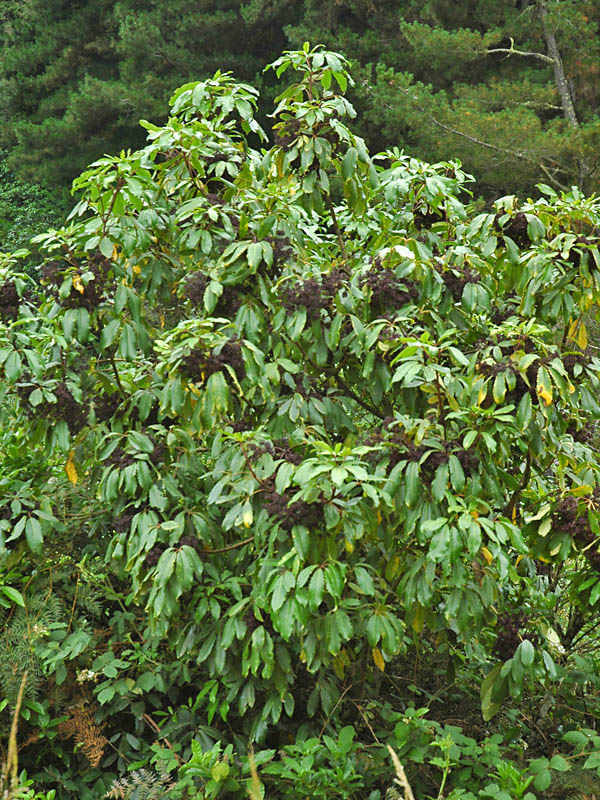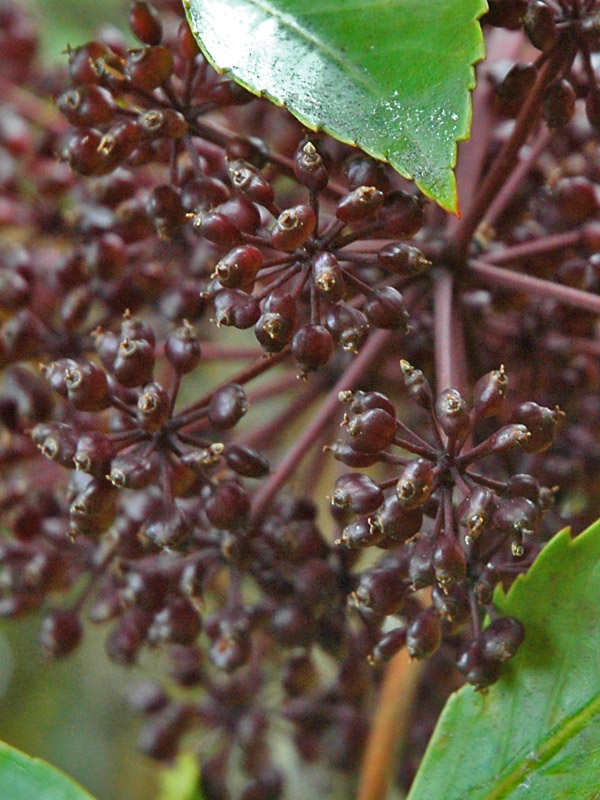
Woody > Pseudopanax > Pseudopanax arboreus > Pseudopanax arboreus
Pseudopanax arboreus
Five-Finger, Puahou
Origin: Native to New Zealand.
| Family |
| Araliaceae |
| Genus |
| Pseudopanax |
| Species |
| arboreus |
| Category |
| Woody |
| Type |
| Shrub (evergreen) |
| Pronunciation |
| USDA Hardiness Zone |
| 9 - 11 |
| Canadian Hardiness Zone |
| Cool season protection under glass. |
| RHS Hardiness Zone |
| H1c - H4 |
| Temperature (°C) |
| -4 - 10 |
| Temperature (°F) |
| 25 - 50 |
| Height |
| 3 - 6 m |
| Spread |
| 4 - 5 m |
Photographs
Description and Growing Information
Flowering Period
| Landscape |
| Specimen plant. |
| Cultivation |
| Full sun or partial shade with moist, well-drained soil. The soil should have a rich organic composition. In terms of reproduction, this species requires that male and female specimens be positioned within range of one another in order to produce fruit on the latter. |
| Shape |
| Rounded and bushy. Its typical stature ranges from 3 to 6 m. |
| Growth |
| Fast |
| Pests |
| Honey fungus. |
| Habitat |
| Sea level, mountainous terrains, lowland regions and edges of forests. |
| Bark/Stem Description |
| Brittle. |
| Flower/Leaf Bud Description |
| Rounded. |
| Leaf Description |
| Palmately compound with 5 - 7 leaflets exhibiting coarse serration along the margins. Ovate with smaller leaflets concentrated near the base of the petioles. Each leaflet is 15 - 20 cm in length. The petioles which support each individual leaflet are 3 - 5c m in length. |
| Flower Description |
| Manifest in groups of 10 - 15 on an umbel inflorescence. The tiny flowers are 5 mm in diameter and can smell sweet. |
| Fruit Description |
| Manifest in tight clusters, 5 - 8mm in diameter and 3 - 6 mm in length for female plants. Most seeds are found in pairs but occasionally may be 3 to a single berry. |
| Colour Description |
| The bark is brown in colour. The buds are reddish-pink colour. Shiny dark green leaflets. The flowers are whitish-pink in colour. The fruit is dark purplish-black. |
| Texture Description |
| Leather-like leaflets. |
| Propagation |
| Clean seeds can be sown in a greenhouse with moderately high temperatures (19° - 24° C in autumn). Seeds should be kept in their own pot in a greenhouse for the first winter. Young plants can be moved at the end of spring or early summer, provided that no further frost is anticipated. Semi-hard cuttings can be take during the winter and set into a frame. Air layering is also recommended. |
| Ethnobotanical Uses (Disclaimer) |
| The bark has been used on occasion to create small raft-like floats or skids for hauling materials. |


